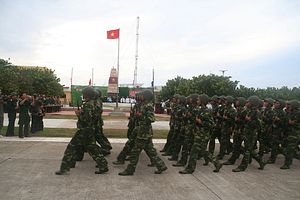Over the past few weeks, another round of tensions has been simmering between China and Vietnam over energy resources in the South China Sea. The renewed tensions fit into a familiar pattern we have seen regarding Chinese conduct in the South China Sea disputes and reinforce the fragility of the situation between claimant states in the strategic waterway.
While China and Vietnam have a long record of engaging in tensions surrounding the South China Sea, the past few years have occasionally seen tensions boil over into conflict, with a case in point being the oil rig incident back in 2014. And despite suggestions by Beijing about relative stability in the South China Sea, tensions between it and Hanoi have continued, including at least two high-profile incidents where China had coerced Hanoi into reconsidering energy exploration efforts.
Over the past few weeks, another round of tensions has been simmering between China and Vietnam. The tensions relate to a standoff near an oil block that lies within Vietnam’s exclusive economic zone (EEZ), where independent analysis confirms that a Chinese survey ship, supported by other vessels, has been conducting activities that Vietnam says violate its EEZ and continental shelf. On Friday, Vietnam’s foreign ministry said that Hanoi had demanded that China stop the “unlawful activities” and have the aforementioned ships leave Vietnamese waters.
While some specifics remain unclear, the incident fits into a familiar pattern where China has been obstructing efforts by other claimant states in the South China Sea to carry out energy exploration activities, including through periodic activities that could result in escalation. While the focus of these efforts may be on Vietnam, they have also been seen with Malaysia, and China also has a history of engaging in these acts with the Philippines as well despite the warming of ties underway under President Rodrigo Duterte. The official statement by the United States on the matter makes clear that this has a wider regional significance beyond the single incident itself and reflects Washington’s growing willingness to speak out against these actions under the Trump administration.
It is also yet another important reminder, as I have argued before, that despite ongoing efforts to manage tensions, be it be it multilateral ones such as the quest for a binding code of conduct or bilateral ones like China-Philippine negotiations, the illusion of calm in the South China Sea betrays the fragility of the situation between claimant states. It is worth remembering that just the first half of 2019 alone has seen tensions crop up at various times between China and Vietnam, the Philippines, and Malaysia to varying degrees, along with developments in China’s approach such as the continued fortification of its artificial islands and missile tests.
The path forward in this latest round of tensions remains unclear. There is a chance that Beijing and Hanoi may yet find a way out to this current round of tensions without escalation, but this cannot be taken for granted given previous incidents between the two countries. But looking further ahead, the bigger question is how regional states can manage a reality where China continues to advance its own claims and related activities at their expense, at times without due regard for international law and often using the full weight of its economic and military capabilities, which dwarf that of other claimants.

































